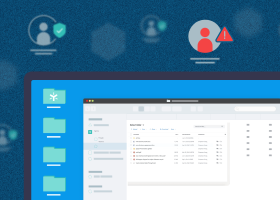Insider Threat Indicators
Insider threats have long been overlooked or not given sufficient IT Security attention. However, these users hold legitimate credentials that provide varying degrees of access to an organization’s sensitive IT resources, including networks, applications, and systems.
The damage that malicious or careless insiders can and do inflict has made understanding insider threat indicators a priority for security operations.

| What Are Insiders and Insider Threat Indicators? Insiders can be any person with authorized access to internal information and systems. They can include staff, former employees, consultants, partners, and other internal users. Insider threat indicators can identify malicious insiders and provide advanced warnings of nefarious activities. |
Even the most upstanding of those internal users could be identified as a risk by understanding and monitoring their insider threat indicators. These are the users who inadvertently compromise systems or data. In some cases, it is not the actual internal user, but someone who has stolen credentials to conduct malicious activities without the end-user’s knowledge.
Other times, employees inadvertently misuse or expose sensitive resources and data (e.g., falling for a social engineering ploy, having a device lost or stolen, or sharing emails or files incorrectly).
Staying on top of insider threat indicators also shines a light on the malicious insider. Those users intentionally seek to do harm and commit fraud. Following insider threat indicator clues, their activities can be detected and stopped to prevent or at least mitigate damage to the organization.
Insider Threat Detection
Implementing a proactive strategy to monitor insider threat indicators puts organizations ahead in the battle to defend data and systems. Due to the variety of insider threat indicators, a number of different tactics and systems need to be employed to neutralize them. Following are several commonly used approaches to monitoring insider threat indicators and providing protection from internal threats.
Assessments
Performing organization-wide risk assessments provides visibility into critical assets, vulnerabilities, and the insider threats that could affect them. In addition, internal users should be evaluated to identify insider threat indicators.
Education and Training
Include insider threat detection awareness and insider threat detection indicators as key components of users’ cybersecurity training curricula. Educate team members, consultants, and contractors on how to be mindful of their activities to avoid becoming an unwitting insider threat, as well as how to monitor for and identify insider threat indicators.
Mailbox Journaling
Use mailbox journaling to record email communications as part of the organization’s email retention strategy. Add e-discovery software to help uncover insider threat indicators proactively.
Physical Controls
Physical security controls should be implemented across an organization. These should include insider threat indicator detection support, such as logging access to secure areas where sensitive systems are housed and monitoring all critical facilities using video cameras with motion sensors and night vision capabilities.
Policies
Criteria should be established for insider threat indicators. In addition, policies should be developed to manage ongoing monitoring of these. Processes should also be set to ensure the ongoing enforcement of policies related to insider threat indicators—keeping the list of criteria current and directing responses to insider threats.
Additional policies that should be in place to handle insider threat indicators detection are:
- Account management policy
- Incident response policy
- Password management policy
- Third-party access policy
- User monitoring policy
Remote Access Monitoring
Monitor and control remote access from all endpoints, including mobile devices. Regularly conduct remote access audits to determine if employees still require remote access, terminate access when it is no longer needed, and ensure that all remote access is terminated when an employee leaves the organization.
Software Controls
A wide variety of security software and appliances can be used to detect insider threats and identify insider threat indicators. A few commonly used tools are:
- Data loss prevention solution
- Encryption software
- Endpoint protection system
- Intrusion detection system (IDS)
- Intrusion prevention system (IPS)
- Privileged access management system
- Session screen-capture technology on all critical servers and devices that are accessed by privileged users
- Spam filters
- Traffic monitoring software
- Multi-Factor Authentication (MFA)
- User access management and control for all devices that connect to the network
- User and entity behavior analytics, or UEBA
- Web filtering solution
Insider Threat Indicators
Electronic Insider Threat Indicators
- Accessing sensitive data that is not required for primary job functions
- Browsing the corporate network in search of sensitive data
- Copying files that contain sensitive data frequently
- Downloading or accessing substantial amounts of data
- Exhibiting abnormal user behavior
- Transferring sensitive data outside the organization by email or other communications channels
- Using unauthorized storage devices (e.g., flash memory, USB sticks, removable hard drives)
Workplace Insider Threat Indicators
- Accessing networked resources while on vacation, sick leave, or holidays
- Attempting to enter secure areas without authorization
- Being disgruntled to the point of potential retaliation
- Exhibiting disregard for security rules
- Expressing extreme interest in subjects and projects outside of the scope of job position and function
- Having significant IT Security policy disagreements
- Leaving the organization—willingly or at the organization’s behest
- Receiving poor performance reviews
- Seeking to gain higher clearance or expand access outside the job scope
- Staying in the office during off-hours
- Trying to bypass any security measures
- Violating security policies
- Working extra hours
Personal Insider Threat Indicators
- Displaying key interpersonal vulnerabilities that could be exploited by bad actors:
- Drug or alcohol addiction
- Gambling issues
- Financial troubles
- Suspicious or unexplained financial gain
- Unusual international travel
How Insiders Become Insider Threats
Insider threat indicators point to a number of ways that internal users become insider threats. These are categorized as accidental or malicious.
Accidental Insider Threats
There are occasions where insiders unintentionally become a security threat. These accidental insider incidents take various forms, such as sending an email with sensitive information to the wrong recipients, falling for a phishing scam, or inadvertently sharing account credentials with others. Usually, these insiders are unaware that they have put the organization at risk or caused harm. The result of human error, these incidents make up the bulk of insider threats.
Malicious Insider Threats
Driven by a specific purpose, malicious insiders are triggered in a number of ways, including:
- Espionage
Sharing sensitive information with a complicit partner, such as a competitor or foreign government - Fraud
Modifying, stealing, or destroying data for monetary gain - Intellectual property theft
Stealing sensitive information, often to sell or use at another job - Revenge
Conducting an attack for the sole purpose of retribution, commonly perpetrated by a disgruntled employee - Sabotage
Seeking to damage or destroy an organization’s sensitive data, applications, or systems
Insider Threat Behavior Prediction Theories
Several theories are taken into consideration when trying to determine motivations for becoming a malicious insider threat and identifying insider threat indicators.
- General deterrence theory
Crimes are committed when an insider determines that the benefits outweigh the potential personal costs. - Social bond theory
An insider commits a crime because they do not have social bonds of attachment, commitment, involvement, or belief with an organization. - Social learning theory
Connecting with malicious peers drives an insider to become a threat to an organization. - Theory of planned behavior
Potential insiders can be identified by assessing insider threat indicators related to their attitude, subjective norms, and perceived behavior control towards crime.
Use Insider Threat Indicators to Enhance Security
Efforts to improve cybersecurity are unceasing. IT teams spend vast amounts of time responding to and defending against vulnerabilities.
An approach that is often not widely deployed is managing insider threat indicators. Developing an understanding of the insider threat indicators within an organization and using monitoring systems to identify them allows organizations to enhance overall security by preventing the accidental and malicious insider threats that are considered the most common cause of data breaches.
Egnyte has experts ready to answer your questions. For more than a decade, Egnyte has helped more than 16,000 customers with millions of customers worldwide.
Last Updated: 19th April, 2022




